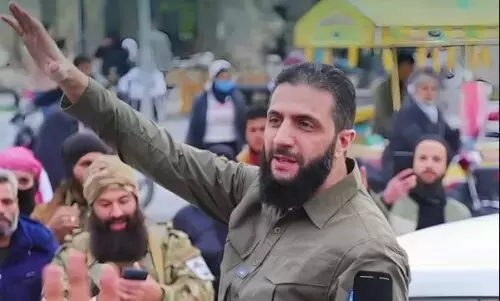
Insurgents led by the Islamist group Hayyat Tahrir al-Sham remain the most organised of the groups which have taken control of the country since their lightning offensive on Dec 8. File photo of Ahmad al-Sharaa
Syria: A tenuous peace exists, but factional disputes prevent unified authority
A journalist saw an argument break out when HTS fighters tried to stop members of another faction from taking abandoned army munitions

Forty-five days after Bashar al-Assad flew to Moscow after a sudden rebel onslaught ended decades of family rule, a tenuous peace exists in Syria. But the country is yet to have a unified and central authority.
Insurgents led by the Islamist group Hayyat Tahrir al-Sham (HTS) remain the most organised of the groups which have taken control of the country since their lightning offensive on December 8.
Since then, HTS leader Ahmad al-Sharaa has called for a national army and security forces. The interim defence minister, Murhaf Abu Qasra, is meeting various armed groups in a bid to execute the plan.
Factional disunity
But some prominent leaders like southern rebel commander Ahmad al-Awda have refused to attend the meetings, underlying the various divisions that have traditionally marred rebel unity even when al-Assad was in power.
Also Read: Syria’s post-civil war future: New challenges under Ahmad al-Shara
Wariness has highlighted questions about how the interim administration can bring together a patchwork of former rebel groups, each with its own leaders and ideology.
The southern province of Daraa is widely seen as the cradle of the Syrian uprising in 2011 after anti-government protests were met with repression by Assad's security forces.
Foreign backers
The rebel groups that formed in the south had different dynamics from those in the north. They were less Islamist, said Aron Lund, a fellow with the Century International think-tank.
All the groups had different backers too.
“In the north, Turkey and Qatar favoured Islamist factions very heavily,” said Lund. “In the south, Jordanian and American involvement nudged the insurgency in a different direction.”
Also Watch: Watch | Syria faces uncertain future after Assad
Earlier peace plan
A 2018 Russian-mediated “reconciliation agreement” with Assad's government saw some groups lay down heavy weapons, but most light weapons remained in rebel hands.
When the HTS-led rebel groups based in the north launched their surprise offensive last year in Aleppo, the weapons still with them were put to use again.
Factions in the southern provinces of Daraa, Sweida, and Quneitra reactivated, forming a joint operations room to coordinate with northern ones.
Truce bid that failed
It is also now emerging that officials from several countries backing either the rebels or the al-Assad government met in Qatar on what to do on December 7.
The countries involved in the process were Turkey, Russia, Iran, Qatar, Saudi Arabia, Jordan, and Iraq.
Also Read: Indians evacuated from Syria recall panic, ‘anti-social elements in streets’
It was agreed then that the insurgents would stop their advance in Homs, the last major city north of Damascus, and that internationally-mediated talks would be held with al-Assad on a political transition.
Battle for Damascus
But the insurgent factions had other ideas. Within 24 hours, they had raced to reach Damascus. Shortly before that happened, al-Assad fled his palace and hurriedly boarded a plane that took him to Russia.
Unilateralism still plagues Syria where different authorities hold different areas.
An Associated Press journalist saw an argument break out when HTS fighters tried to stop members of another faction from taking abandoned army munitions.
Armed groups
During a visit by AP journalists to the western countryside of Daraa province this month, there was no visible presence of the HTS forces.
At one former Syrian army site, a fighter with the Free Syrian Army, the main faction in the area, stood guard in jeans and a camouflage shirt.
Also Read: 75 Indian nationals evacuated from Syria reach Beirut
Other local fighters showed off a site where they were storing tanks abandoned by the former Syrian army.
“Currently these are the property of the new state and army, whenever it is formed," said one fighter, Issa Sabaq.
The process of forming those has been bumpy.
On New Year's eve, factions in the Druze-majority city of Sweida in southern Syria blocked the entry of a convoy of HTS security forces who had arrived without giving prior notice.
Local armed factions are still the de facto security forces in many areas.
